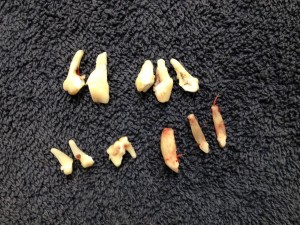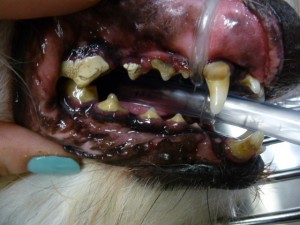Dental disease is probably one of the most unrecognized diseases by owners. And while vets are a bit better at getting a good look in the mouth, not even we can visualize pockets and tooth root disease during a routine physical exam. The most common symptom that alerts owners to a problem in the mouth is halitosis (aka: yuck-breath). But by this time there is often such advanced disease involving the tooth roots and perhaps even the bone sockets and jaw bones that the bad breath is really just the tip of the ice berg.
"But dogs and cats in the wild don't have to worry about dental disease." True story. But there is also probably a strong genetic predisposition toward healthy teeth in wild animals. Imagine a wild cat trying to capture and eat prey with a rotten set of teeth. That trait wouldn't last too long in the wild and would probably get weeded out of the genetic pool pretty quick. Sweet Fluffy did not come to you from the wild. Her parents were probably not wild and her great great grandparents probably weren't either. For many generations there has been less and less of a need to stalk, catch and tear apart prey. Fluffy's mouth and the mouth of many generations before her have adapted to a diet of kibble and canned food. And the honest truth is that you really don't need a single tooth to eat those kinds of foods. (You know you've seen a Labrador inhale its food without chewing one bite!) At DTLAvets we have 3 cat patients that have literally ZERO teeth in their mouth and will not eat anything but dry food. They just gum away at their kibble and are super happy kitties. A toothless mouth is a way happier place than a mouth full of rotten teeth. But how does a pet get to the point of needing extractions?
Here's how it all goes down. First a biofilm (bazillions of bacteria) coats the tooth - kinda like those fuzzy sweaters we feel on our teeth when we haven't brushed for a while. When this biofilm mixes with the saliva, over time and in the absence of regular brushing, plaque starts to form. The plaque eventually calcifies and with more time, becomes tartar. Both plaque and tartar can induce gingivitis: red, swollen gums. And there you have it - once gingivitis has set in, it is a sign that there is some degree of disease under the gum line, at the level of the tooth root.
Now what if we took this mouth to an anesthesia-free service and only cleaned the crowns of the these teeth?
We've done nothing for the gingivitis, because almost no animal, no matter how sweet and docile they are, will allow you to do root work while they are awake. Also the tools that are commonly used in anesthesia-free services tend to have sharp points that leave micro-grooves in the teeth. Without properly polishing the teeth, these grooves serve as perfect attachment sites for more bacteria to adhere to in the future. So the animal leaves its anesthesia-free dental cleaning (often times still with bad breath) and the owner is very pleased with how clean the crowns of the teeth look. Six months later you could have something like this:
A tooth root abscess! Yup, that's literally pus coming out from the gum tissue. (Note how "clean" these teeth look, btw.)
Whenever there is gingivitis, it's really important to completely evaluate and treat the teeth, and this includes the roots! X-rays and careful probing of all sides of each tooth are the only way that we can evaluate the teeth and their roots properly. And this does require anesthesia.
"But I"m really nervous about putting my pet under general anesthesia." We know. And we take this very seriously. We perform a full physical exam prior to anesthesia so that we can listen to the heart and make sure that there is nothing that may make anesthesia unsafe for your pet. We do a blood test beforehand to make sure that the liver and kidneys are working properly - these are the main organs that have to handle and then excrete the anesthesia. Just like in humans, every anesthesia carries a small risk, but we do everything we can before and during to make sure that anesthetic risk is as tiny as possible. And when we consider the riskiness of allowing dental disease to advance, we feel that the small anesthetic risk is overshadowed by things like root infection, bone destruction and even organ dysfunction and blood disease that can come from a constant showering of those nasty bacteria into your pet's body.
For many years, February has been touted as Veterinary Dental Health Month. Many vet hospitals will offer specials and other incentives for dental cleanings and other dental work during this month. At DTLAvets we believe that every month should be Dental Health Month! We try to make dental cleanings as accessible as possible to everyone. Our hope is that if anesthetic dental cleanings are economically practical, more pets will have complete dental care more often and have a much better chance of avoiding serious and costly oral disease. We include a follow-up visit in the price of our dental cleanings. At this visit we will give you advise and demonstrations on how to keep your pet's mouth as clean as possible for as long as possible. Even for those cats who make toothbrushing a living nightmare, there are other options that are worth incorporating into their home routines to keep their mouth a happy place.
Make an appointment with us for a dental consultation today. We'd love to help your pet have a truly healthy and happy mouth.
(Many thanks to Moteck and Wrigley for providing us with visual aids.)


